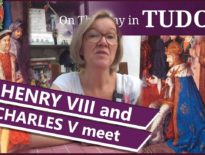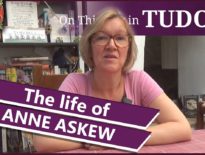On this day in Tudor history, 25th May 1551, at around noon, Croydon and several Surrey villages, in the south of England, experienced a “great shaking of the ground”, in other words, an earthquake.
In today's talk, I share descriptions of this earthquake, as well as other Tudor earthquakes, such as the famous 1580 Dover Straits Earthquake, which caused fatalities and damage.
Read "A warning for the wise, a feare to the fond, a bridle to the lewde, and a glasse to the good Written of the late earthquake chanced in London and other places, the. 6. of April 1580. for the glorie of God, and benefite of men that warely can walke, and wisely can iudge", Churchyard's pamphlet on the 1580 eathquake, at
https://quod.lib.umich.edu/e/eebo/A18767.0001.001?view=toc
Also on this day in Tudor history, 25th May 1553, Lady Jane Grey got married to Lord Guildford Dudley, son of John Dudley, Duke of Northumberland. They weren't the only couple to get married in the ceremony at Durham House, Jane's sister, Katherine, and Guildford's sister, Catherine, also got married. Find out more in last year’s video:
Also on this day in history, 25th May...
- 1524 – Death of Sir Thomas Lovell, administrator and Speaker of the House of Commons, at Elsings in Enfield.
- 1537 – Hanging of John Pickering, Dominican friar, at Tyburn. Pickering had been found guilty of treason for his part in the Pilgrimage of Grace uprising.
- 1554 – Edward Courtenay, Earl of Devon, was moved from the Tower of London to Fotheringhay Castle. He had been implicated in Wyatt’s Rebellion.
- 1607 – Funeral of John Rainolds (Reynolds), theologian and President of Corpus Christi College, Oxford. He was buried in the college chapel.
- 1625 – Death of William Barlow, philosopher and Church of England clergyman. He was buried in the chancel of Easton church, the church where he was rector.
- 1632 – Death of William Knollys, 1st Earl of Banbury and courtier. He was the son of Sir Francis Knollys and Catherine Carey, and grandson of Mary Boleyn. He was buried at Rotherfield Greys.
Transcript:
On this day in Tudor history, 25th May 1551, at around noon, Croydon and several Surrey villages, in the south of England, experienced a “great shaking of the ground”, in other words, an earthquake.
Frances Godwin, Bishop of Hereford recorded in his “Annales of England” that “On the five and twentieth of May, Croydon and seven or eight other Villages in Surrey were terribly shaken with an Earthquake” and 17th century clergyman and historian John Strype recorded in his Ecclesiastical Memorials “May 25, about Rygate, Croydon and Dorking was felt an earthquake, and especially at Dorking; insomuch that there, and elsewhere, pots, and pans, and dishes fell down, and moved about.”
It was not the only earthquake felt in Tudor England.
On 19th September 1508, in the reign of King Henry VII, an earthquake was felt in England and Scotland. In his Annales of Scotland, Sir James Balfour described it as “a dreadful earthquake… which lasted the 10 part of an hour, to the great terror and astonishment of all the inhabitants.”
In July 1534, in the reign of King Henry VIII, an earthquake was felt in North Wales and Dublin, Ireland. It was mentioned in a Welsh poem and by Sir James Ware in his History of Ireland.
Then, on 26th February 1575, in the reign of Queen Elizabeth I, an earthquake was felt in Yorkshire, North Wales, Herefordshire, and Gloucestershire. The British Geological Survey states that from contemporary sources, we know that Hatfield in Yorkshire suffered the most damage. Their report states “At this place some old houses and barns were thrown down and part of the gable end of the manor house fell. Near Hatfield, supposedly, churches were “laid flat with the ground” and “great damage was done in all the country over”.
Five years later, on 6th April 1580, the Wednesday of Holy Week, a large earthquake known as the Dover Straits Earthquake was recorded. The British Geological Survey states that its epicentre was between Dover and Calais and that it was felt as far as York, and possibly even Edinburgh. It was also felt in Northern France, the Low Countries and into Germany. Aftershocks were noted on 1st and 2nd May. There were fatalities in the Low Countries and London, sections of wall fell in Dover, St Peter’s Church in Sandwich, Kent, suffered damage, as did Saltwood Castle in Kent, in Essex, a portion of Stratford Castle collapsed, and stones fell from Ely Cathedral in Cambridgeshire. The earthquake was seen as a portent and pamphlets were published urging people to repent. I’ll give you a link to read Thomas Churchyard’s pamphlet “A warning for the wise, a feare to the fond, a bridle to the lewde, and a glasse to the good Written of the late earthquake chanced in London and other places, the. 6. of April 1580. for the glorie of God, and benefite of men that warely can walke, and wisely can iudge”, but here is his description of the earthquake in London:
“On Wednesdaye in the Easter weeke, beyng the sixt day of April. 1580. betwene the houres of fiue and sixe in the euening, hapned generally through all the City of London, & the Suburbes of the same (as it were in a moment and vppon the sodaine) a wonderful motion and trembling of the earth, in somuch, as Churches, Pallaces, Houses, and other buildings did so quiuer and shake, that such as were then present in the same were tossed too and fro as they stoode, and others, as they sate on seates, driuen off from their places: some leaning backewardes, were readye to fall: and manye besides so shaken standing, that it broughte suche terror to those that were in the same houses, that the most part feared, their houses woulde come downe vpon them, and therevppon ranne oute of their doores in greate perplexitie, to see whether their houses were stil standing in their wonted place or no. And some houses did so crackle, that the tables and stooles, with other furniture, as Brasse and Pewter, so tottered, that it was thought they would haue fallen to the ground, and the houses reste insunder. And this chaunced not only in London (& the suburbs of the same) but also in diuers other parts through the nerest places of our knowlege in Englād. But specially about S. Katherins, the Limehouse, & Radcliffe, where the people were so maruellously amazed, that it was pitifull to beholde how fearefully they ranne oute of their doores, and howe strangely one would beholde an other, thinking verilye, that the latter daye hadde bene come. And the houses on London bridge didde shake euen in the same sort as in other parts of the Citie. Whereby it appeareth, that the sayd trembling and mouing of the earth, did not onely passe vnder the houses on the firme ground, but also vnder the riuers and waters. And to signifie better the generalitie of the same, you shal vnderstād, that the Abbey Church at Westminster, was there with so shaken, that one of the Pinacles of the same, loste aboue one foote of his toppe, the stones whereof fel to the ground. Also the stéeple in the Pallace so shoke, that the bell of the great Clocke sounded therewith, as thoughe it hadde bene stricken with some hāmmer. Also at White Hall where hir Maiestie lieth, the great Chamber & other parts of the Court so shooke, as séemed strange to such as were present. The new Hall of the middle Tēmple did so shake also, as it caused a number of Gentlemēn (being set to Supper) to run forth with their knives in their hands, fearing that it woulde fall. It chanced also, Tho. Cobhed being in the pulpit in Christes church in Newgate market, preaching to the people, sodenly the church so shooke, that out of the roofe of the same fell certayne greate stones, by the fall whereof, a boy named Thomas Gray, apprentice to Iohn Spurling Shoomaker, was brayned, and Mabell Eueret his fellowe seruaunt, was stricken on the heade with a stone, being daunge∣rously hurt, but is not dead: and a num∣ber of the people (by hasting to flee and scape away) were sore brused and hurt, by falles and suche like accidentes.”
Churchyard then breaks into verse in which he states that the earthquake was “sent from fathers hand, to make the childe to knowe, The rodde is neare their backes, that out of order goe” and concluding with a call for people to heed this “good warning” from God.
The 1580 earthquake may even have been alluded to in Shakespeare’s Romeo and Juliet, when Juliet’s nurse says “Tis since the earthquake now eleven years”, although it could also refer to the 1584 earthquake felt in Western Switzerland.
So, there you go, some Tudor earthquakes!



Leave a Reply